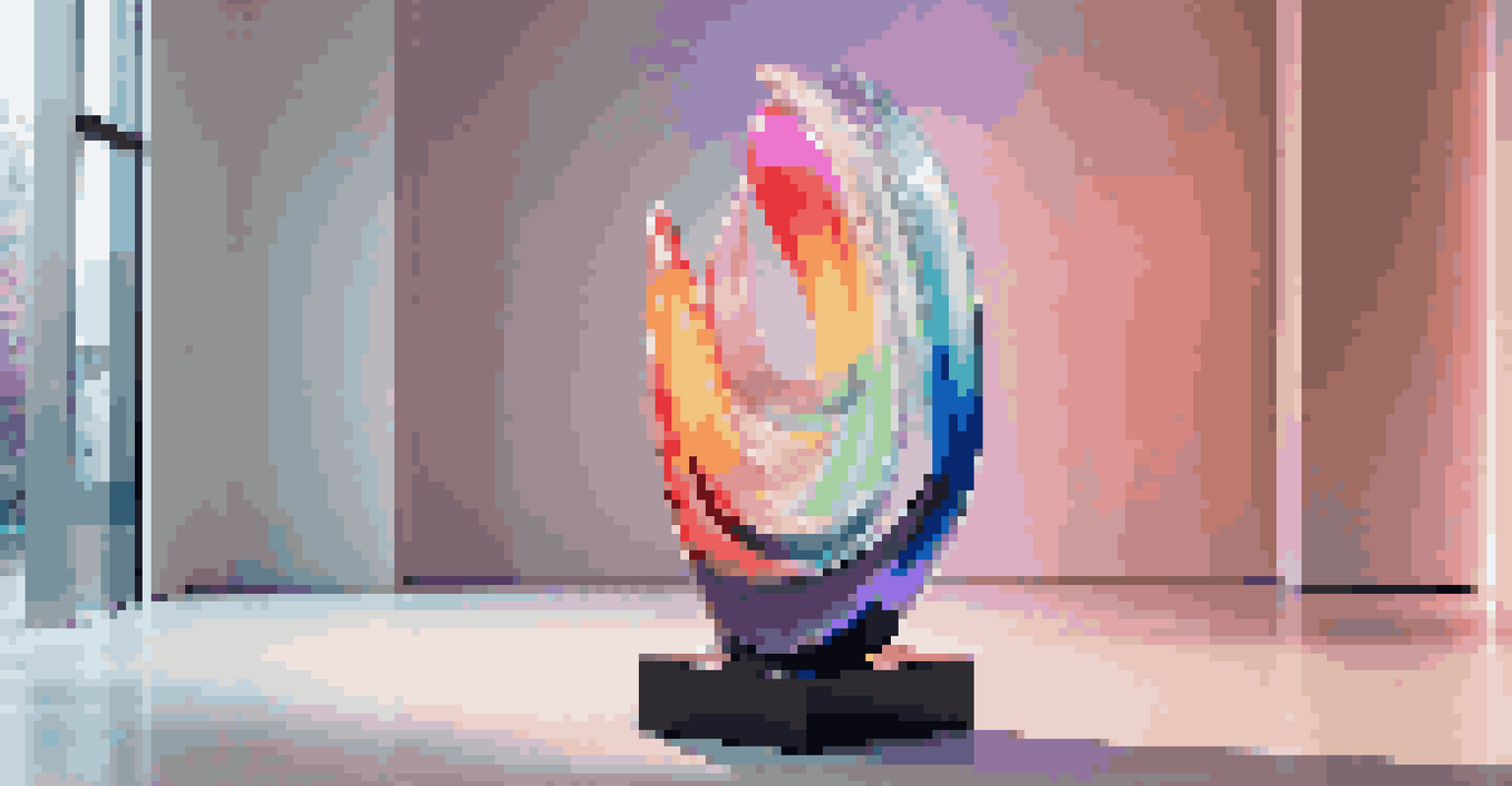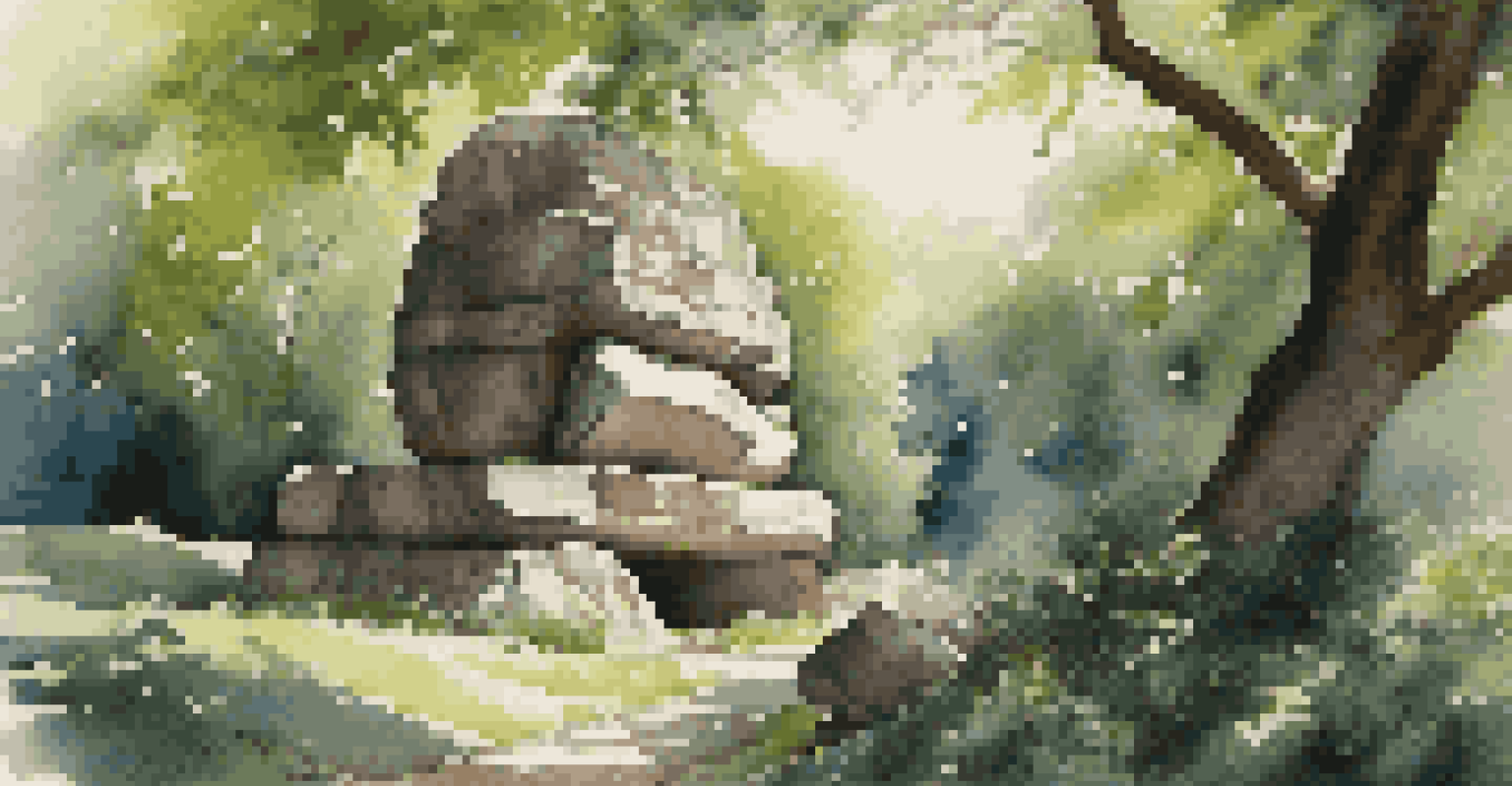Sculpture and the Sense of Touch: A Deep Dive

The Importance of Touch in Sculpture Appreciation
Sculpture is a unique art form that engages our sense of touch, making it distinct from paintings or photographs. This tactile quality invites viewers to not just observe, but to imagine how the artwork might feel beneath their fingertips. The very material of a sculpture, whether it's cold marble or warm wood, can evoke different emotions and responses. By considering touch, we deepen our appreciation and understanding of the artist's intentions and techniques.
Art is the most beautiful of all lies.
When we think about touch, we often relate it to memory and sensation. For instance, a smooth bronze surface may remind someone of childhood experiences, while rough stone may evoke a sense of nature. These connections make the experience of viewing sculpture deeply personal. As viewers, we engage with the artwork in a way that transcends the visual, creating a multi-sensory experience.
Moreover, the act of touching sculptures has historical significance in many cultures, where it was common to interact physically with art. Although modern practices often discourage this due to preservation concerns, the desire to touch remains strong. This longing illustrates just how integral touch is to our human experience, especially in the realm of three-dimensional art.
Material Choice: How Texture Influences Experience
The choice of material in sculpture plays a crucial role in how we perceive and relate to a piece. Artists select materials not only for their aesthetic qualities but also for the tactile sensations they can evoke. For example, glass sculptures can be smooth and reflective, creating a sense of elegance, while clay sculptures often have a more organic, earthy feel. Each material tells its own story through texture, enhancing the viewer's connection to the work.

Take the example of a wooden sculpture; its grain and warmth invite a different interaction than a polished stone piece. The textures can evoke feelings of comfort or coldness, drawing the viewer into a deeper emotional response. This interplay between material and touch can transform the way we experience art, turning a simple viewing into a tactile journey.
Touch Enhances Sculpture Appreciation
Engaging with sculptures through touch creates a multi-sensory experience that deepens our understanding of the artwork.
Furthermore, artists often manipulate textures deliberately to provoke interaction. By incorporating rough and smooth surfaces, they create visual contrast that invites exploration. This encourages viewers to engage their sense of touch mentally, even if they cannot physically interact with the piece. In this way, the choice of materials becomes a vital component of the sculpture's narrative.
The Role of Scale: How Size Affects Tactile Perception
Scale is another critical aspect of sculpture that influences how we perceive touch. Larger sculptures can evoke a sense of awe and grandeur, making us feel small in comparison. This physical distance may hinder our ability to connect through touch, yet it can amplify our emotional response. The sheer size of a piece can turn it into a monumental experience, challenging our perceptions of space and interaction.
The purpose of art is not a rarified, intellectual distillate; it is life, intensified, brilliant life.
Conversely, smaller sculptures often invite intimacy and personal connection. These pieces can be held or examined closely, allowing for a more hands-on approach. This tactile engagement creates a unique bond between the viewer and the artwork, as they can feel the details and nuances that larger pieces may obscure. In this way, the scale of a sculpture shapes not only its impact but also our connection to it.
Moreover, the environment where a sculpture is displayed can affect our interaction with its scale. In a vast museum hall, a large sculpture may feel overwhelming, while in a cozy gallery, it may seem inviting. Understanding these dynamics helps us appreciate how scale modifies our sensory experience and interaction with the artwork.
Cultural Perspectives: Touch in Sculpture Across Cultures
Different cultures have unique perspectives on the sense of touch and its significance in sculpture. For instance, many Indigenous cultures view their sculptures as living entities, meant to be touched and interacted with. This belief fosters a deep connection between the artwork and the community, emphasizing touch as a vital part of cultural identity and expression. In these contexts, sculptures are not merely objects, but integral components of a larger narrative.
In contrast, Western art traditions often prioritize visual aesthetics over tactile engagement. Many museums enforce strict no-touch policies to protect the art, which can create a barrier between the viewer and the work. This raises interesting questions about accessibility and the meaning of art in a society that increasingly values sensory experiences. The cultural approach to touch can highlight differing values in how we appreciate and interact with art.
Material Choice Affects Perception
The texture and type of materials used in sculptures significantly influence how viewers emotionally connect with the pieces.
Exploring these cultural differences invites us to reflect on our own relationship with sculpture. It challenges us to consider what we may be missing by limiting our interaction to visual observation. By acknowledging and embracing diverse perspectives on touch, we can cultivate a richer understanding of sculpture as a universal form of expression.
The Impact of Technology on Tactile Sculpture Experiences
As technology advances, it brings new opportunities for enhancing our tactile experiences with sculpture. Virtual reality (VR) and augmented reality (AR) offer innovative ways to explore sculptures without physical contact. Users can interact with 3D models, experiencing the textures and forms in a digital space. This technology provides an accessible way to engage with sculptural works, especially for those unable to visit galleries in person.
Additionally, 3D printing allows artists to experiment with textures and forms that may be challenging to create with traditional methods. This opens up a world of possibilities for tactile exploration, as artists can manipulate textures in ways that were previously unimaginable. The result is a new dimension of interaction, where viewers can appreciate the intricate details and sensations of sculptures from the comfort of their homes.
However, while technology can enhance our experiences, it also raises questions about the authenticity of touch. Can a virtual interaction truly replicate the feeling of physically engaging with a sculpture? As we navigate this digital landscape, it's essential to balance traditional tactile experiences with modern innovations, ensuring that the essence of sculpture remains intact.
Educational Approaches: Teaching Touch in Sculpture
Educators play a vital role in fostering an appreciation for touch in sculpture through hands-on learning experiences. Art programs that encourage students to create and interact with 3D works promote a deeper understanding of texture and form. By engaging physically with materials, students can explore the tactile qualities that define sculpture, enhancing their artistic skills and creativity. This experiential learning approach can ignite a passion for art and deepen students' connections to the medium.
Moreover, workshops that incorporate touch can bridge the gap between visual art and sensory experience. By allowing participants to handle various materials, instructors can illustrate how different textures influence perception. This hands-on approach encourages individuals to think critically about the role of touch in their own artistic processes, fostering a generation of artists who value sensory engagement.
Cultural Views Shape Touch Interaction
Different cultural perspectives on touch in sculpture highlight the varying significance and accessibility of tactile engagement in art.
Incorporating tactile experiences into art education also cultivates empathy and understanding. When students explore the emotional responses elicited by different textures, they learn to appreciate the diverse experiences of others. This holistic approach to sculpture education not only enhances artistic skills but also promotes cultural awareness and emotional intelligence.
The Future of Tactile Sculpture: Trends and Innovations
As we look to the future, the integration of touch in sculpture continues to evolve alongside societal changes and technological advancements. Artists are increasingly experimenting with interactive installations that invite viewers to engage more actively with their work. These pieces often blur the lines between the viewer and the artwork, creating a sense of collaboration and shared experience. This shift highlights the growing importance of touch as a fundamental aspect of contemporary art.
Additionally, sustainable materials are emerging as a trend in sculpture, emphasizing the tactile qualities of eco-friendly resources. Artists are exploring how natural textures can connect us to the environment, fostering a deeper understanding of our relationship with nature. This movement not only enhances the sensory experience but also promotes environmental consciousness in the art world.

Ultimately, the future of tactile sculpture lies in its ability to adapt and resonate with audiences. By prioritizing touch and sensory engagement, artists can create works that invite deeper exploration and connection. As we continue to engage with sculpture in new and innovative ways, the sense of touch will remain a vital aspect of our artistic journey.